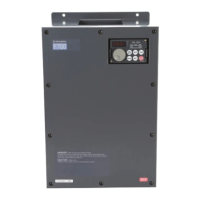How to fix PU disconnection in Mitsubishi Electric FR-F740 EC Inverter?
- NNorma BowenSep 10, 2025
To address PU disconnection on your Mitsubishi Electric Inverter, fit the FR-DU07 or parameter unit (FR-PU04/FR-PU07) securely.

How to fix PU disconnection in Mitsubishi Electric FR-F740 EC Inverter?
To address PU disconnection on your Mitsubishi Electric Inverter, fit the FR-DU07 or parameter unit (FR-PU04/FR-PU07) securely.
What to do for stall prevention (overcurrent) on Mitsubishi Electric FR-F740 EC Inverter?
To address stall prevention due to overcurrent in your Mitsubishi Electric Inverter, verify that the setting for Pr. 0 "Torque boost" is not excessively high.
What to do for stall prevention (overvoltage) on Mitsubishi Electric FR-F740 EC?
To resolve stall prevention caused by overvoltage in your Mitsubishi Electric Inverter, increase the deceleration time using Pr. 8 "Deceleration time".
What to do if Mitsubishi Electric FR-F740 EC shows an error?
If your Mitsubishi Electric Inverter shows an error, turn off the RES signal. Then, check the connection between the PU and the inverter, and also check the voltage on the inverter's input side.
How to fix retry count excess in Mitsubishi Electric Inverter?
To address a retry count excess error on your Mitsubishi Electric Inverter, eliminate the cause of the error preceding this error indication.
How to fix inrush current limit circuit alarm in Mitsubishi Electric FR-F740 EC?
To address an inrush current limit circuit alarm in your Mitsubishi Electric Inverter, connect an AC reactor.
What to do for Stall prevention on Mitsubishi Electric FR-F740 EC?
To address stall prevention in your Mitsubishi Electric Inverter, reduce the load weight.
How to fix output side earth fault overcurrent protection in Mitsubishi Electric FR-F740 EC Inverter?
To resolve an output side earth fault overcurrent protection issue with your Mitsubishi Electric Inverter, remedy the earth fault portion.
How to fix motor overload shut-off (electronic thermal relay function) in Mitsubishi Electric FR-F740 EC?
To resolve motor overload shut-off (electronic thermal relay function) in your Mitsubishi Electric Inverter, reduce the load weight.
How to fix overcurrent shut-off during constant speed in Mitsubishi Electric FR-F740 EC Inverter?
To resolve an overcurrent shut-off during constant speed with your Mitsubishi Electric Inverter, ensure the load remains stable.
| Type | Inverter |
|---|---|
| Rated Output Current | Varies by model |
| Cooling Method | Fan Cooled |
| Humidity | 95% RH or less (non-condensing) |
| Enclosure Rating | IP20 |
| Output Frequency | 400Hz |
| Control Method | V/F control |
| Overload Capacity | 150% for 60 seconds |
| Protection Features | Overcurrent, Overvoltage, Undervoltage, Overheating, Short Circuit |
| Communication Options | RS-485 |
| Application | Fans, Pumps, HVAC |
| Protection | IP20 |
| Operating Temperature | -10°C to +50°C |
| Storage Temperature | -20°C to +65°C |
| Altitude | 1000m or less |
Details the identification format for FR-F740 and FR-F746 EC inverters.
Guidelines and conditions to consider for proper inverter panel installation to prevent faults.
Specifies minimum clearances for heat dissipation and accessibility, and mounting orientation.
Overview of system configuration, showing connections between the inverter and peripheral devices.
Illustrates the wiring connections for main circuit, control circuit, and communication terminals.
Details the specifications and layout for connecting main circuit terminals.
Describes the functions of control circuit terminals and input/output signals.
Covers leakage currents, inverter-generated noises, and EMC filters for compatibility.
Essential safety and handling precautions to prevent damage and ensure correct operation.
Guidance on performing settings and commands for motor operation.
Instructions for setting the electronic thermal relay function to protect the motor from overheat.
Explains how to perform operations using the PU, including frequency commands.
Selection of operation command location and frequency command location.
Details parameters for manual torque boost and simple magnetic flux vector control.
Details on motor protection functions like electronic thermal relay and PTC thermistor input.
Configuration of input and output terminals for various functions like start, speed, and alarms.
Settings for automatic restart, power failure deceleration, and operation continuation.
Configuration of retry functions and alarm code output for handling various alarms.
Functions to prevent misoperation and restrict parameter changes, including password protection.
Guides on selecting operation modes (PU, external, network) and control sources.
Details on communication protocols and settings for PU connector and RS485 terminals.
Configuration and calibration of PID control for process applications like pumps and fans.
Provides guidance on identifying and resolving operational issues and errors.
Guidelines for daily and periodic inspection, cleaning, and parts replacement.
Provides a list of operation panel indications, names, fault data codes, and refer pages.
Details error messages, their causes, and corrective actions for various fault conditions.
Troubleshooting guide for common issues like motor not starting or speed variations.
Basic daily and periodic checks to prevent faults caused by operating environment or aging.